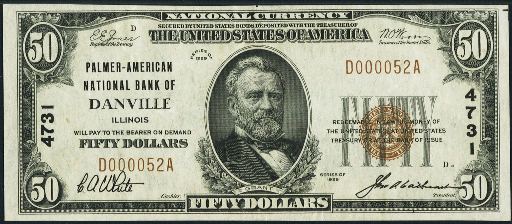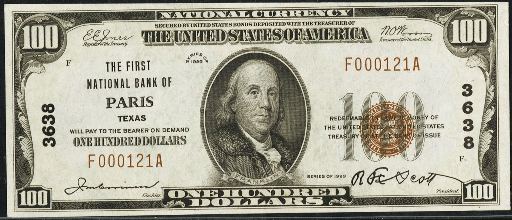The Fidelity National Bank & TC Of Kansas City
The Fidelity National Bank & TC Of Kansas City in Missouri printed $4,926,200 dollars worth of national currency. Over $1,000,000 face value is a lot of money. However, some types and denominations of currency from this bank could still be rare. This national bank opened in 1919 and stopped printing money in 1933, which equals a 15 year printing period. That is actually quite brief in terms of bank existence. During its life, The Fidelity National Bank & TC Of Kansas City issued 5 different types and denominations of national currency. We have examples of the types listed below. Your bank note should look similar. Just the bank name will be different. For the record, The Fidelity National Bank & TC Of Kansas City was located in Jackson County. It was assigned charter number 11344.
We buy all national currency. Please call or email us for a quote. Sales@AntiqueMoney.com
The Fidelity National Bank & TC Of Kansas City in Missouri printed 138,940 sheets of $5 1902 blue seal national bank notes. Sadly, a printing range that high means that these blue seal bank notes from this bank are not going to be extremely rare. Ben Harrison is on the front of all 1902 $5 blue seal bank notes. This happens to be the smallest denomination issued for the 1902 series. Each note is complete with a blue seal and blue charter number. Despite saying series of 1902, these were actually issued by national banks between 1908 and 1928. There are two different types of blue seals. The first type is called a date back and it has “1902-1908” written on the back of the bill. The other type is called a plain back; it does not have the date stamps on the back of the bill. The values for these notes range widely based on condition and the bank of issue.
1902 $5 Blue Seal National Bank Note
The Fidelity National Bank & TC Of Kansas City printed 9,358 sheets of Type1 1929 $10 national bank notes. Sadly, based on a number that high, there is basically no chance for these notes to be especially rare. Each $10 bill from 1929 has a portrait of Alexander Hamilton on it. The black number written vertically is the charter number. The charter number never affects the value; it is just an identifier. The ten dollar type1 national bank note happens to be the single most common national bank note, with over 65,000 known to exist from all banks. Of course each note is valued based on its condition and rarity. Some are very rare.
Series of 1929 Type1 $10 National Bank Note
The Fidelity National Bank & TC Of Kansas City also printed 8,831 sheets of Type1 1929 $20 national bank notes. Sadly, based on a number that high, there is basically no chance for these notes to be especially rare. Andrew Jackson is featured on the front of each 1929 $20 bill. Be sure to take note of the serial number on your specific bank note. If it is 000001 then you can expect a nice premium. There is a special market for serial number one bank notes. Of course, even if the number isn’t #1, it could still be collectible and have a high value just based on its condition and rarity alone.
Series of 1929 Type1 $20 National Bank Note
The Fidelity National Bank & TC Of Kansas City also printed 862 sheets of Type1 1929 $50 national bank notes. This is a small print range, but it does not guarantee rarity. As is the case with all modern fifty dollar bills, Ulysses Grant is pictured on the front of 1929 $50 bills. This is a higher denomination that was only printed by 300 different national banks. Many examples are only worth around a few hundred dollars. Rarer specimens can sell for more than $1,000.
Series of 1929 Type1 $50 National Bank Note
The Fidelity National Bank & TC Of Kansas City also printed 446 sheets of Type1 1929 $100 national bank notes. That may sound like a very small number, and it is. However, when it comes to small size notes, that print range usually allows for a handful of survivors. Despite saying series of 1929, all type1 national bank notes were actually printed between 1929 and 1933. Exactly 289 national banks printed $100 type1 notes. Most are relatively common. However, as with anything, there are always exceptions to that rule.
Series of 1929 Type1 $100 National Bank Note



